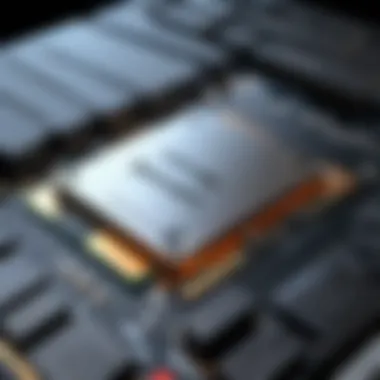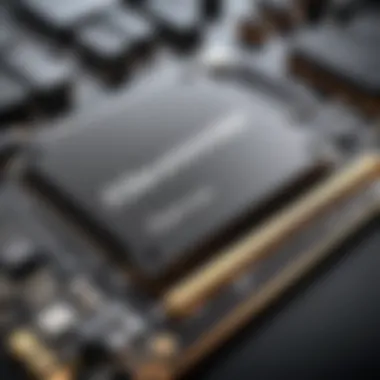Maximizing Performance: RAM Limits of Lenovo X1 Carbon


Intro
In today's fast-evolving tech landscape, understanding the specifications and capabilities of a laptop is crucial, especially for power users. The Lenovo X1 Carbon series, known for its sleek design and formidable performance, is no exception. This guide focuses on the maximum RAM capabilities of the Lenovo X1 Carbon, dissecting its architecture and what it means for users who require more memory for activities such as gaming or intensive applications.
Product Overview
Brand Information
Lenovo, a prominent name in the technology sector, has made a strong impression with its ThinkPad series, of which the X1 Carbon is a part. Known for quality and reliability, Lenovo targets professionals and tech enthusiasts alike. Built with the user's needs in mind, the X1 Carbon has gained accolades for its performance and portability.
Key Specifications
This particular laptop series supports a maximum RAM of 16GB or 32GB, depending on the model and configuration ordered. Previous iterations have had more limited capacities, showcasing an increasing flexibility in memory options. Some of the standout specifications to consider include:
- Processor: Intel Core i5 or i7 (varying generations based on model year)
- Display: 14-inch, up to 4K resolution
- Storage: SSD options ranging from 256GB to 2TB
- Weight: Approximately 2.5 pounds
Pricing
The pricing for the Lenovo X1 Carbon varies significantly depending on the processor, RAM, and storage capacity configurations. Base models can start around $1,200 while more advanced versions an go above $2,000. Understanding these price points is critical when assessing the value in relation to computing needs.
Performance Comparison
Benchmark Tests
When considering performance, benchmarks play a vital role. Many users place emphasis on the RAM's impact on multitasking and overall system speed. In tests, models with 32GB RAM show a marked improvement in processing tasks such as video editing and simulation modeling compared to 16GB, which is a satisfactory but restricted option.
Speed and Efficiency Comparisons
Users are often concerned with response times and application load speeds. While both RAM options perform admirably, the gains from higher RAM capacity are particularly evident in extreme workloads.
Features and Technology
Unique Features
Among the standout features of the X1 Carbon is the keyboard, which adds typist-friendly efficiency. Users find comfort during long hours of work due to its tactile feedback. Additionally, the laptop includes a range of connectivity options such as Thunderbolt 3 ports, enhancing its versatility.
Technological Advancements
Importantly, Lenovo integrates Rapid Charge technology, allowing up to an 80% charge in just an hour, which is invaluable for users constantly on the go. RAM specifications can be a decisive factor here; higher capacities support more seamless multitasking.
Compatibility with Other Devices
The X1 or Digital Devices support USB-C connections and can work nicely with USB-C equipped monitors and peripherals, eliminating compatibility issues during workflows.
Pros and Cons
Strengths of the Product
- Powerful Performance: The maximum RAM capacity enhances productivity,
- Portability: Lightweight and durable, perfect for travel,
- Display: Rich graphics with impressive resolution options.
Areas for Improvement
- Pricing: Higher models reach premium pricing points,
- Upgradability: Some users find restrictions on RAM upgrades, depending on the model.


Value for Money
Cost-Effectiveness
For users needing high-efficiency performance, investing in models with greater RAM capacity proves beneficial. Performance efficiencies may save time and thus money in professional settings.
Long-Term Benefits
A laptop accommodating higher RAM specifications tends to have a longer cyber-lifetime due to its capability to handle newer, more demanding software.
Comparison with Similar Products
When benchmarked against similar laptops like the HP Elite Dragonfly or Dell XPS 13, the X1 Carbon stands out with unique offerings and displays a favorable balance between performance and price.
Considtering these points helps make an informed decision when investing in hardware. Future-proofing means encompassing RAM capabilities into your purchasing decisions.
Prelude to Lenovo X1 Carbon
The Lenovo X1 Carbon stands as a flagship model within the Lenovo laptop lineup. Understanding this series is essential for anyone looking to optimize computing performance and functionality. The X1 Carbon series is not merely a laptop; it is a blend of engineering, innovation, and design principles that caters to professionals, corporate users, and tech enthusiasts alike.
Overview of the Lenovo X1 Carbon Series
The Lenovo X1 Carbon series has undergone significant evolution since its inception. Known for being featherlight yet robust, these devices offer impressive specifications designed hugely for productivity. Higher-end materials, like carbon fiber, contribute to its lightweight yet durable frame.
Key Features Include:
- Thin Design: The reduced weight and sleek profile enhance portability without sacrificing performance.
- High-Resolution Display Options: users can opt for 4K displays that deliver exceptional clarity and color accuracy.
- I/O Versatility: Multiple ports like Thunderbolt ensure connectivity with a vast array of peripherals.
Performance metrics often see major improvements with each iteration, indicating Lenovo's commitment to refining user experience.
Purpose and Target Audience of the X1 Carbon
The targeted audience for the Lenovo X1 Carbon includes business professionals, frequent travelers, and creatives requiring excellent performance and portability. The intention is clear: to offer a premium device that supports multitasking and intensive workloads without lag.
Notably, the series is geared towards those valuing a balance between performance and form factor. Its specifications draw in productivity-focused users along with tech-savvy individuals looking for hardware that can cope with demand on a daily basis. Frequent travelers particularly appreciate the battery life, assuring usage for extended periods away from power sources.
RAM Specifications of Lenovo X1 Carbon
The specifications related to RAM for the Lenovo X1 Carbon series hold significant importance in evaluating a user's computing experience. The RAM comprises critical functionality that not only impacts day-to-day operations but also determines the versatility and durability of the devices. Understanding these specifications is vital for individuals—especially tech enthusiasts, gamers, and IT professionals—who seek to optimize their laptops for enhanced performance and prolonged use.
An understanding of RAM specifications allows users to assess their needs better. It helps them select a model that meets their performance demands without overspending on unnecessary upgrades. As technology continues to evolve, managing physical memory plays an increasingly important role in multitasking, enabling up-to-date software applications, and ensuring overall system stability.
Types of RAM Supported
Lenovo X1 Carbon models typically support different types of RAM, which are foundational to optimizing performance. Most variants feature Dual In-line Memory Module (DIMM) technology, with specific focus on standards such as DDR4 SDRAM. Users often overlook this specific aspect, but knowing if a device supports DDR4 or an earlier generation is crucial. DDR4, noted for improved speed and lower energy consumption, streamlines operations and makes it suitable for current workloads.
Features of RAM types include:
- DDR4 SDRAM Technology - Used in newer X1 Carbon models, this represents a substantial improvement over earlier versions, such as DDR3 mainly found in older X1 options. Performance-wise, it is significantly faster.
- LPDDR RAM - This low power variant, particularly in more compact models, is designed for energy efficiency without sacrificing too much performance. Given the rise in mobile usage, maintaining battery longevity is a concern that LPDDR addresses.
It is important for users to review these specifications when considering which particular model of Lenovo X1 Carbon will satisfy their requirements, as each type brings unique advantages.
Maximum RAM Capacity
The maximum RAM capacity varies across the Lenovo X1 Carbon series and is influenced by the CPU and motherboard supporting each model. In general, the maximum capacity can reach 32GB in many of the current iterations. This is important for heavy applications and multitasking environments, where users may run virtual machines, expansive datasets, or numerous software tools concurrently.


To offer further understanding, here's a breakdown of practical maximum capacity scenarios:
- Models Released Afer 2019: Most feature support for up to 32GB like the X1 Carbon Gen 8 and the latest generations, allowing extensive flexibility and performance.
Impact of RAM on Performance
The performance of a device, particularly one as sophisticated as the Lenovo X1 Carbon, heavily hinges on its RAM. This section explores the critical significance of adequate RAM and evaluates performance benchmarks that illustrate its impact. Without sufficient RAM, users may encounter bottlenecks, particularly when multitasking or running memory-intensive applications.
Importance of Adequate RAM
Adequate RAM is fundamental for seamless computing experiences. For users who engross themselves in resource-hungry activities like video editing, gaming, or software development, RAM acts as a temporary storage space for operational data. Insufficient RAM can lead to slowdowns and crashes, which implications can be dire, especially for professionals counting on performance.
- Smooth Multitasking: With adequate RAM, multiple applications can run simultaneously without evident lag. Each program has its own memory requirement. Therefore, ample RAM accommodates switching between apps with ease.
- Memory-Intensive Applications: For software that munches on memory resources, such as Adobe suite or virtual machines, having sufficient RAM ensures smooth functionality.
- System Responsiveness: Systems with higher RAM capacity deliver quicker responses. Load times decrease and applications launch faster, resulting in a better user experience.
Performance Benchmarks
To assess the level of RAM’s effect on performance, benchmarks serve as valuable tools. Various standardized tests help analyze how increments in RAM can alter execution speed and system functionality. Here is an examination of typical performance benchmarks that include RAM efficiency:
- Benchmark Test 1: This test often evaluates load times for a specified set of applications. It can depict how increasing RAM might shorten those timelines.
- Benchmark Test 2: This evaluates the system’s performance under heavy usage, like multitasking within different applications, shedding light on performance stability with varied RAM proportion.
- Benchmark Test 3: A specific graphics intensity test showcases how higher RAM capacity allows smoother rendering alongside fewer interruptions throughout the visualization processes.
Effective RAM maximization unleashes the true potential of the Lenovo X1 Carbon, leading to remarkable periods of continuos operation without delays.
In examining these various benchmarks, it is evident that advanced RAM allocation enhances system productivity. Each accumulated detail supports the idea flotation of ensuring the Lenovo X1 Carbon achieves the performance metrics needed by tech enthusiasts and professionals alike.
Comparative Analysis of Lenovo X1 Carbon Models
The Lenovo X1 Carbon series maintains a reputable standing in the market due to its sophisticated design and robust performance capabilities. Yet, among its various iterations, there are notable differences in RAM options, impacting overall user experience and suitability for various tasks. Understanding these distinctions is crucial for potential buyers and current users aiming to optimize their machines’ capabilities.
Differences in RAM Options Across Models
Across the Lenovo X1 Carbon models, RAM configurations exhibit variabllity that can cater to several user needs. The introductory models might come with a baseline of 8 GB DDR4 RAM, which is adequate for basic tasks. However, the higher-end variants can support up to 32 GB of RAM. This increment allows for multiple programs to operate efficiently and improves the device’s multitasking capabilities.
For instance, in the Gen 8 models, Lenovo focused on slightly enhancing both the RAM technologies utilized and the ranges available. Conversely, the Gen 9 models showcase advancements in architecture that enable higher bandwidth and better energy efficiency at a maximum capacity of 32 GB. It is imperative to take into account these specifications when assessing how a model suits professional workloads or intensive use cases.
The specific RAM types supported, such as LPDDR4X in newer iterations, offers advantages in thermal performance and energy consumption compared to its predecessors, which used DDR4. This evolution in RAM options can result in a significant impact on the efficiency and longevity of the device, further justifying the need to examine differences across models engineereed at distinct times in this series.
Suitability for Different Use Cases
Selecting the appropriate Lenovo X1 Carbon model based on RAM options directly correlates with intended use. Primarily, users engaged in typical office work or browsing activities may find the introductory models sufficient, as they limit the need for extensive memory. These standard tasks do not tax the machine’s capabilities and hence moderate RAM is appropriate.
In scenarios involving data analysis, creative tasks, or software development, a higher RAM configuration, preferably 16 GB or above, becomes essential. High Memory configurations tailor well to users who run virtual machines or extensive data sets. For gamers, the extreme limits found in the latest models could prove beneficial, especially with games that demand more from the hardware.
Some specified use cases include:
- Business Professionals: Limited multitasking with typical applications.
- Students: Basic browsing and productivity software.
- Creative Professionals: Video editing or design that requires more memory.
- IT Professionals: Hosting multiple instances of software tools concurrently.
Understanding individual requirements helps fuel informed decisions among Wide rang of buyers and opens the floor for rivalry among tech lovers seeking teh best from their hardware investment.
The consideration of RAM variations between Lenovo X1 Carbon models is pivotal in making an impactful technology purchase. Through carefully assessing use-case suitability alongside RAM capacities, one ensures not only a smart investment but also a smoother operational experience.
Upgrading RAM: Options and Considerations
Upgrading RAM on your Lenovo X1 Carbon can be a critical move for optimizing performance. Whether you are a tech enthusiast, a gamer, or an IT professional, understanding the nuances of your machine’s RAM can provide substantial benefits. A seamless computing experience often hinges on the amount of RAM available during tasks.
For such tasks like multitasking and memory-intensive applications, additional RAM often proves beneficial. It grants greater efficiency and a smoother workflow. In this section, we will explore when to upgrade your RAM and what necessary components and compatibility you must consider.


When to Consider an Upgrade
RAM upgrades may seem insignificant at times, but recognizing the right moment to enhance your machine is essential. Below are indications that it may be time to seek an upgrade:
- Frequent Slowdowns: When applications lag or the system freezes during normal use, it recalls a need for extra memory.
- Limited Multitasking Capabilities: If one application often dominates RAM resources, preventing the use of others, an upgrade becomes necessary.
- Heavy Workloads: Engaging with demanding software like design tools, virtual machines, or high-end games typically requires more RAM.
- Capacity Thresholds: Staying on or above manufacturer specifications is important, as dropping below this can hamper overall performance.
Considering these factors can save you from potential frustration and enhance your overall computing experience.
Components and Compatibility
When venturing into RAM upgrades, comprehension about the components, and their compatibility with your Lenovo X1 Carbon model is vital. Here are the core considerations:
- RAM Type: Ensure you know the supported RAM type, such as DDR4, and speed your system can manage for optimal performance.
- Physical Limits: You must reference your specific model’s maximum RAM capacity. Some models may only support a limited amount.
- Memory Configuration: Some X1 Carbon variants might perform best with specific RAM configurations. This often requires adhering to particular setups or pairs.
- Manufacturer Warranty: Being cautious of the warranty implications of upgrades is of utmost importance to avoid complications down the line.
Mixing incompatible RAM or exceeding supported orders can cause errors during booting.
Incompatible RAM not only causes performance issues, but may also prevent the system from recognizing upgrades altogether.
Understanding your device's specifications and adhering to the requirements ensures a successful upgrade process. You can consult user manuals for compatibility guides or conduct a search on dedicated tech sites if uncertain.
Upgrading RAM is never a trivial task, given its decisive role in differentiating system performance levels. Recognizing the right signals for upgrade while ensuring compatibility can significantly ameliorate your Lenovo X1 Carbon's capabilities.
User Experience and Feedback
User experience is a critical aspect when discussing the RAM capabilities of the Lenovo X1 Carbon. It transcends mere specifications, highlighting how users interact with their devices. Understanding the nuances of user feedback helps potential buyers make informed choices, ensuring that they select configurations that best match their needs.
When considering RAM, it impacts everything from boot times to handling processes efficiently. Feedback shared by users often reflects their day-to-day tasks and the emotional responses accompanying these interactions.
Common Use Cases Reported by Users
Users of the Lenovo X1 Carbon span a variety of professions and personal needs. Each demonstrates distinct scenarios in which RAM plays a pivotal role. Some common use cases displayed by users include:
- Professional Tasks: Many Lenovo X1 Carbon users are in productivity-intensive roles such as graphic design, software development, and multitasking across professional applications. They appreciate sufficient RAM for seamless transitions between applications.
- Gaming: It is clear that gamers value the system's ability to handle memory-heavy games. Users report upgrading RAM to enhance gaming experiences, particularly for titles that demand quick responsiveness and rich graphics.
- Content Creation: Video editors and music producers often rely on substantial RAM to facilitate smooth, real-time editing without latency. Their feedback frequently cites speed advantages when using suitable RAM capacities.
These examples show that the demands of daily tasks significantly determine user needs and satisfaction.
User Reviews and Recommendations
A wealth of information is embedded in user reviews regarding the Lenovo X1 Carbon and its RAM capabilities. Many point out several useful recommendations:
- Maximum Capacity Awareness: Users often advise future buyers to be well aware of each model’s RAM limitations before purchasing. Selecting models with higher RAM capabilities, like those able to support 32GB, can prolong the laptop's relevance and performance.
- Consideration of Daily Tasks: Experienced users often recommend assessing one's own workload before deciding on RAM upgrades. Flor example, casual users might find 8GB sufficient, while power users may justify investing in higher specifications.
- Real-World Performance Assessment: Feedback suggests trying to read reviews from current users who share insights about their experiences. Many cite improvement in speed and performance post-upgrade.
By emphasizing these points, potential users can benefit from the shared experiences of others, tailoring their approach to selecting a configuration that best suits their required performance.
Ending and Future Insights
In this article, we explored various aspects of RAM capabilities within the Lenovo X1 Carbon series. Memory specifications directly influance performance, user experience, and overall functionality of devices. By understanding these features, users can make well-informed decisions tailored to their specific needs. Considering the increasing demand for high-performance computing, the insights provided here offer much-needed perspective for tech enthusiasts, gamers, and IT professionals alike.
Summary of Key Findings
- RAM Specifications: Different models of the Lenovo X1 Carbon support varying types of RAM, but often fall within similar performance tiers.
- Expansion Options: The ability to upgrade RAM is strategic, as it can notably enhance productivity for intensive tasks.
- Performance Needs: Users' configurations and tasks should dictate the RAM size; those multitasking or using resource-hungry applications will require higher capacities.
More RAM improves online operations as well as offline tasks, ensuring that user workflows are optimized for performance.
Looking Ahead: Future Developments in RAM Technology
Technological advancements in RAM design can have a significant strategy on future Lenovo X1 Carbon models. Emerging technologies such as DDR5 memory promise greater speed and efficiency, allowing users to handle complex applications far better than previous generations. As data necessitates evolve, demand for faster RAM will likely grow, incentivizing the pursuit of more adaptable storage solutions.
Continuous innovations will transform performance expectations, with specifics such as energy efficiency and enhanced data transfer rates becoming critical consideration. There will be refinements aimed at maximizing heat dissipation and longevity, catering to both power users and general consumers alike.
By keeping abreast of these trends, Lenovo X1 Carbon users can maintain relevance and take full advantage of developments in RAM technology.







